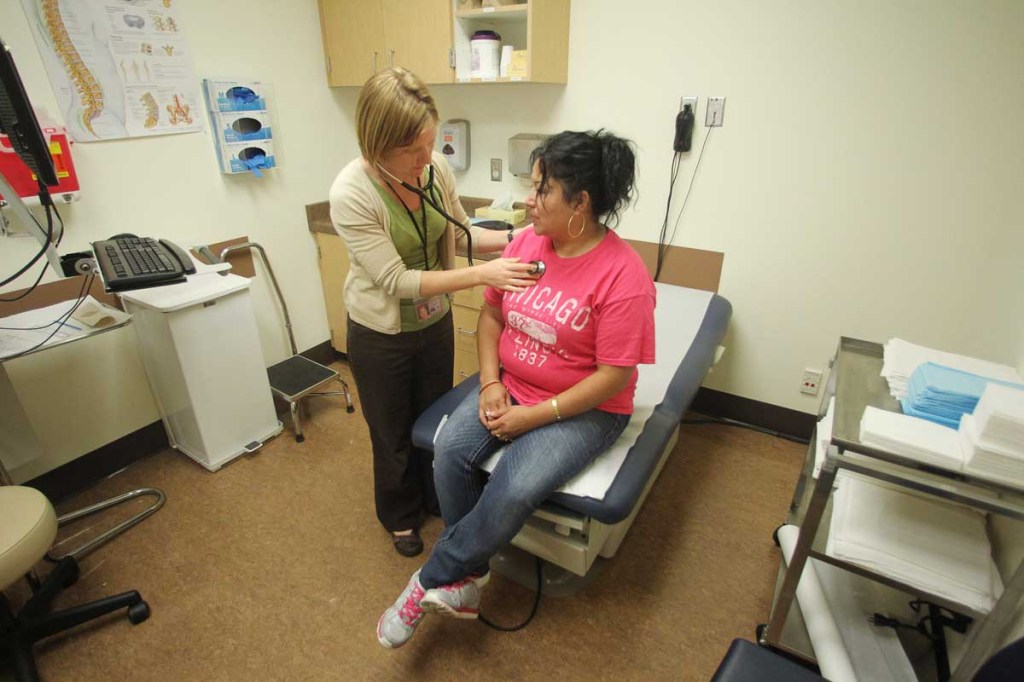Winners, losers emerge from GOP health care tax credits
Published 5:15 am Thursday, March 9, 2017

- In this June 25, 2012 photo, physician assistant Anna Streuli, left, examines Maria Guzman at the Multnomah County's Mid-county Health Center, in Portland, Ore.
WASHINGTON — House Republican leaders tout their replacement plan for the Affordable Care Act, also known as Obamacare, as the best way to lower the price of health insurance for Americans.
An examination of the plan’s details by the Kaiser Family Foundation doesn’t entirely support that premise when comparing tax credit subsidies between the GOP proposal and Obamacare for individuals purchasing their own insurance.
Trending
While many lower-income Americans will get higher tax credit subsidies to help pay for premiums, there will also be many who won’t, including individuals like Meredith Ryan, a paralegal making $21,000 in Montgomery County, Texas.
Ryan, 46, suffers from diabetes. Obamacare subsidies allow her to buy a level of health insurance that covers the cost of such necessities as a $5,000 insulin pump she wears instead of giving herself several shots throughout the day.
The less generous GOP plan would reduce her $3,670 annual subsidy by $670, according to a county-by-county comparison by Kaiser. That could force her to buy higher deductible coverage or make up the difference for the same benefits.
“They’re screwing the little people again,” said Ryan.
Unlike Obamacare, the House plan does not consider income or the cost of premiums in determining the size of the tax credits. Instead subsidies are based primarily on age, rising as people get older.
The House Ways and Means Committee began public hearings Wednesday on the Republican plan, which has already drawn fire from some GOP senators and congressmen for being either too liberal or too frugal. Democrats have banded against the approach as hurtful to lower-income Americans while also increasing the federal debt.
Trending
In addition to lowering the tax credit subsidies, the plan rolls back in 2020 Medicaid rules that expanded health insurance to more than 11 million people in 31 states; eliminates the requirement that people have insurance or pay a penalty, and gives larger employers the option of offering insurance coverage to fulltime employees.
West Virginia Republican Sen. Shelley Moore Capito said she’s concerned federal government cutbacks in Medicaid coverage could force cash-strapped states like hers to finance health insurance for their poorest residents..
The plan does retain two popular elements of Obamacare: coverage for individuals with pre-existing conditions, and young people can remain on their parents’ health insurance until age 26.
Rep. Kevin Brady of Texas, chairman of the Ways and Means Committee, and other Republican leaders are highlighting what they consider positive changes, claiming that when all is said and done, the GOP plan will reduce the cost of health insurance.
They admit, however, their income-based tax credit subsidies creates winners and losers even in the same county.
In Walker County, an East Texas rural area represented by Brady, 40 year olds making $20,000 a year would receive about $3,000 in tax credits, or about $2,520 less than they get under Obamacare, according to the Kaiser analysis.
Yet persons in that age bracket making up to $75,000 and living in Walker County could also qualify for $3,000 in tax credits even though now they make too much to receive subsidies.
Cynthia Cox, a Kaiser health policy analyst, said the House plan would help upper middle-income people who struggle to pay for insurance, but it would come “at the expense of lower-income people.”
Fiscal conservatives like Sen. Rand Paul, R-Ky.,are critical of the tax credit approach.. “It keeps Obamacare subsidies but renames them ‘refundable credits,’” he wrote in a Twitter post.
The chief criticism Republicans have of Obamacare is the law’s broad insurance coverage requirements. Brady told a news conference Tuesday that feature has raised premiums and loaded coverage with benefits people don’t want.
Republicans could not say Wednesday whether the replacement legislation would insure more people than now and House Democrats are opposed to moving forward without an answer to that question.
Brady said by eliminating mandated health insurance, Americans will be able to choose between plans with different levels of coverage and prices, including catastrophic care — although those would have higher co-payments.
Instead of health care “tailored to Washington’s needs,” consumers will be able to buy insurance “tailored to what they need,” said Brady.
Kaiser’s Cox said the House plan could help some very low-income people left behind by Obamacare, such as those living in urban areas. Only those making at least the national poverty level — $12,060 for an individual, $24,600 for a family of four – are eligible for subsidies under Obamacare.
In addition, Cox said, 2.5 million poor Americans were left without insurance in the 19 states that did not accept Obamacare’s expanded Medicaid coverage.
Under the Republican plan, they would be eligible to receive tax breaks starting in 2020 at these levels: $2,000 for people under age 30, $2,500 for people ages 30 to 39, $3,000 for people age 40 to 49, $3,500 for people age 50 to 59, and $4,000 for people age 60 and over starting in 2020.
Cox said the amounts would only be enough to help the very poor buy “skimpy” catastrophic insurance.
Also standing to benefit, she said, are low-income people who live in urban areas like Essex County, Massachusetts.
A 40-year-old in that suburban Boston county making $20,000 receives only about $2,450 in insurance premium subsidies under Obamacare, but would get $3,000 in tax credits under the Republican plan.




